 After a nasty selloff in late August, stocks temporarily gave investors a bit of hope (a dangerous emotion in trading) by rallying higher in the first half of September, but the bullish enthusiasm was short-lived.
After a nasty selloff in late August, stocks temporarily gave investors a bit of hope (a dangerous emotion in trading) by rallying higher in the first half of September, but the bullish enthusiasm was short-lived.
Due to an abundance of overhead supply left in the wake of the August decline, the main stock market indexes ran out of gas in mid-September, then headed south again after running into powerful overhead resistance of their 50-day moving averages.
Now, as we enter the last quarter of the year, the major indices are toying with crucial support of their prior lows from August.
This begs the obvious question on the minds of millions of investors right now; is the test of August lows a buying opportunity OR is now the time to shift to cash and/or sell short stocks?
Unlike the omniscient “gurus” of mainstream financial media, we do NOT claim to have the definitive answer to that question (and it’s ridiculous to believe anyone who says they do).
But in this article, we do seek to answer that question through objective, “no nonsense” technical analysis of the current state of the broad market.
Continue reading for our concise chart reviews of the NASDAQ Composite, S&P 500, Russell 2000, and two other useful confirmation indicators…
Brief Buy Signal
After bouncing off its August low (and prior to running into resistance of its 50-day MA), the NASDAQ Composite actually triggered a buy signal in our proprietary market timing model, which is part mechanical and part discretionary.
The initial buy signal of our timing system is typically mechanical, while the discretionary component is designed to confirm the strength of the signal because all market timing signals are NOT created equally.
The actual confirmation of any buy signal is always a process, rather than a one-day event, because it takes a bit of time to gauge the quality and quantity of emerging bullish trade setups and fresh breakouts to new 52-week highs (if there are any).
Although we cautiously dipped our toes back in the long side of the market after receiving our recent buy signal, heavy volume selling suddenly began showing up to ruin the party.
This prompted us to write the following in the September 21 issue of The Wagner Daily: “With 3 of the past 8 sessions qualifying as distribution, the odds of the current rally following through without further downside are very slim. Friday’s gap down (Sept. 18) also suggests more selling within the next day or two.”
Promptly heeding the warning of bearish distribution days without emotion, we notified subscribers the following week that we were cancelling the buy signal and shifting to neutral mode.
Since then, the NASDAQ Composite has plunged 6.4%, tumbling lower in five of the last seven trading sessions.
Not surprisingly, the broad market sell-off to test the prior lows caused several of our long positions to hit their protective stops, but that’s exactly what our timing model is designed to do; keep traders out of trouble by cutting losses when market conditions deteriorate, while also signaling the best time to jump back into the market and start buying again.
Neutral OR Sell?
Simply put, a weekly close below the August lows (respectively) of the Russell 2000, NASDAQ, or S&P 500 indices would definitively shift our market timing system from “neutral” to “sell” mode.
Let’s take a look at each of these indexes, so that we may determine how close we are to breaking below those critical support levels.
As of the close of Monday, September 28, the small-cap Russell 2000 Index was the first and only index to break below its prior low from August:
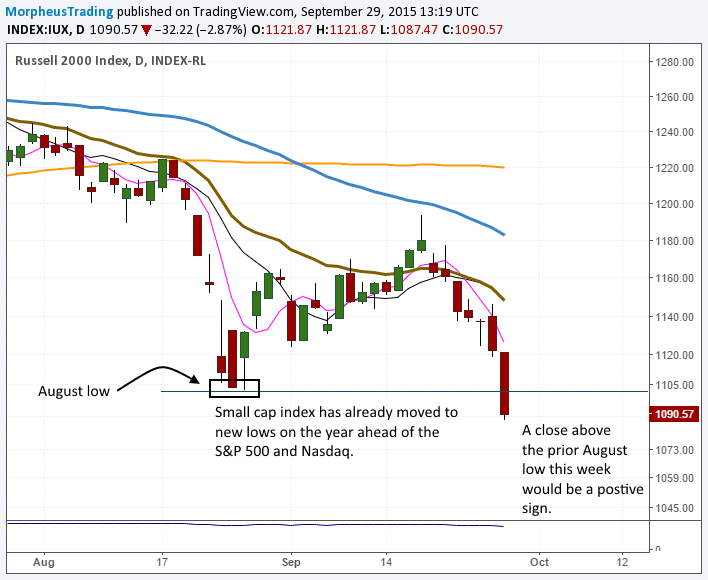
Although we said that a break below the prior lows of August would be negative for the market, we find it to be most important whether or not the index closes the week below the crucial area of support.
As such, the performance of the Russell over the next few days could tell us a lot; either the bulls return to buy the “undercut” of the prior low OR a lack of buying interest could cause the index to attract more selling momentum, which could send the index on another leg lower.
The benchmark S&P 500 Index may soon follow suit with an undercut of its August low:
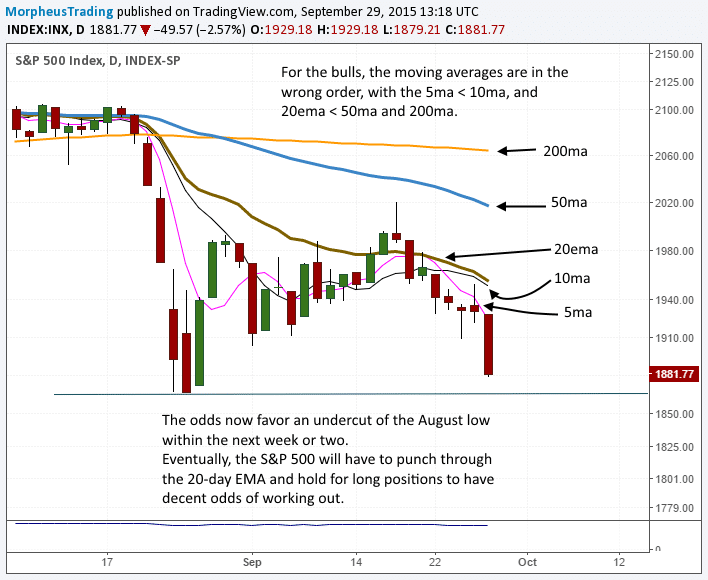
Due to the strong bounce off its August low, the NASDAQ Composite Index has the best shot of holding up.
On the chart below, notice that the 61.8% and 78.6% Fibonacci retracement levels may provide support in the coming days, but even if the NASDAQ blows through those levels and slips all the way back down to last month’s low, such a move would likely trigger a substantial bounce (at least in the near-term).
If you’re currently sitting on any short positions in the NASDAQ, stay alert and prepared to lock in any swing trading profits on the short side because there is a plethora of support here and just below current levels:
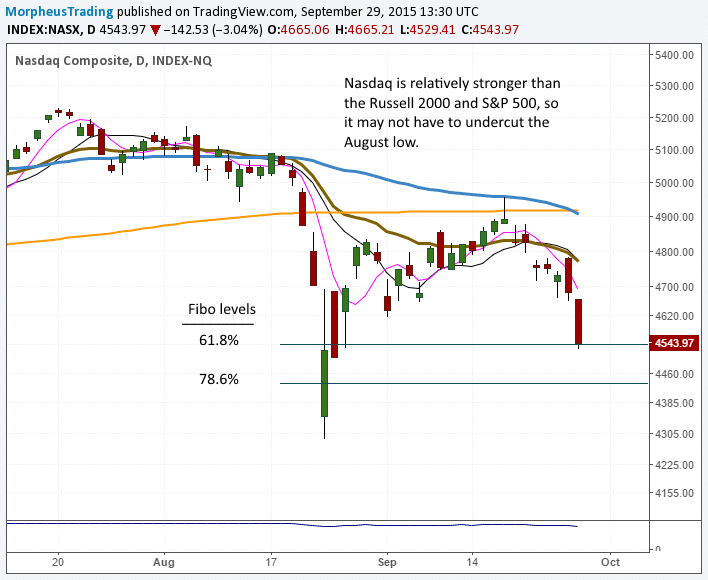
One index we use merely as for confirmation of broad market action is the CBOE Volatility Index ($VIX).
Generally, the higher the $VIX index, the more volatility should be expected in the market.
The $VIX held above its 50-day MA last week, and is now back above its 20-day EMA as well, neither of which is a good sign for bulls:
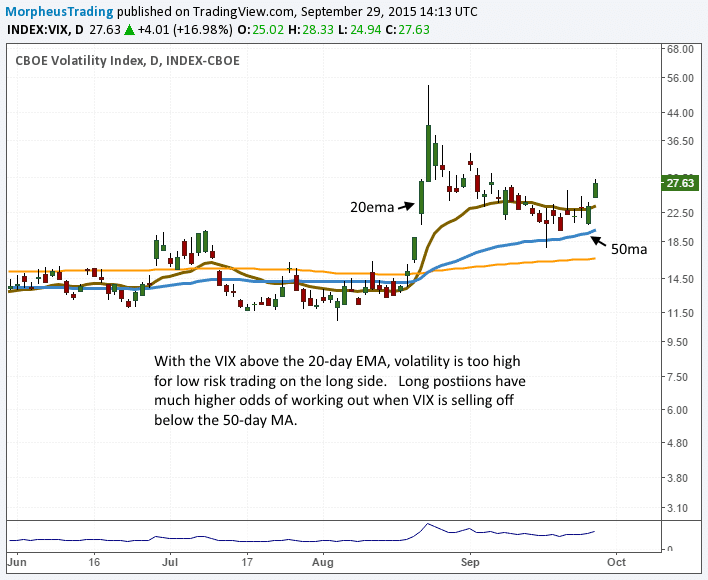
Since most stock market rallies in recent years have coincided with a selloff in treasury bonds, the daily chart pattern of iShares 20+ Year T-Bond ETF ($TLT) can be useful at helping to anticipate the stock market’s next move. Take a look:
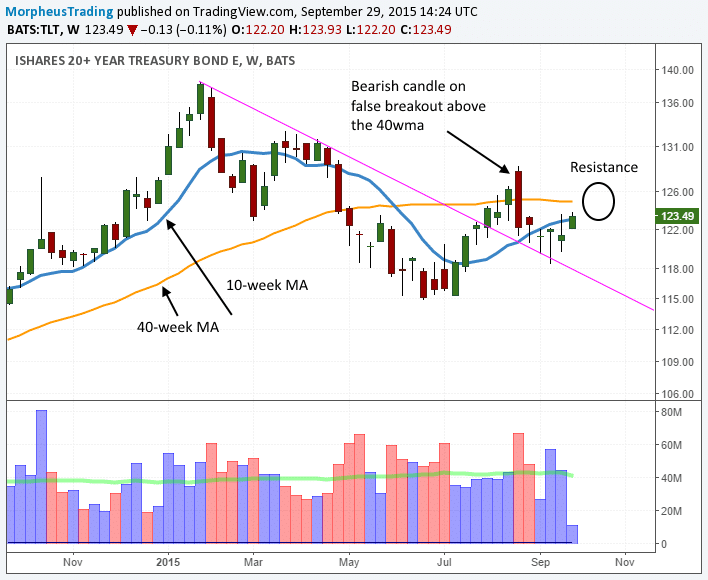
The current bounce in the bond market may soon find resistance at its 40-week MA (similar to the 200-day MA) and bearish reversal candle in late August. If it does, it could aid the bullish case for stocks.
However, even if the long-term bond index fails to push above the August high, it still may not lead to a stock market sell-off right away.
Instead, the index could chop around in the $115 to $118 area, near the recent lows, for quite some time (the major market averages could go into “chop mode” as well).
A best case scenario for supporting a stock market rally would be a breakdown below $115 in $TLT.
Trade What You See, NOT What You Think!
With our style of trading, the focus is placed on what the market is doing right now, and NOT what it could be doing in the future.
The roadside is littered with the remains of traders who “had a strong hunch” or were “quite certain” the market will move in a particular direction.
That’s why we live by the mantra to always trade what we see, NOT what we think.
Living and breathing this mantra allows us to keep our thoughts in the present and go with the flow, which runs counter to many traders who do the opposite by first developing an opinion on where the market should go, then sticking with that opinion even when it is clearly wrong.
If you find yourself trading without discipline of a rule-based market timing system, or found yourself lost during the recent correction in the market, sign up now for your risk-free subscription to our nightly swing trading newsletter and learn a most disciplined, yet simple, approach to trading.

Make a chart. I see it as the long term MACD in coordination with long term stochastics indicating a buy in point for most markets, also the long term channels have what looks like good support at the uptrend support line. Of course with Putin, Obama, Syria, and the mid-east also at crises stages, all of my opinion could be poppycock…